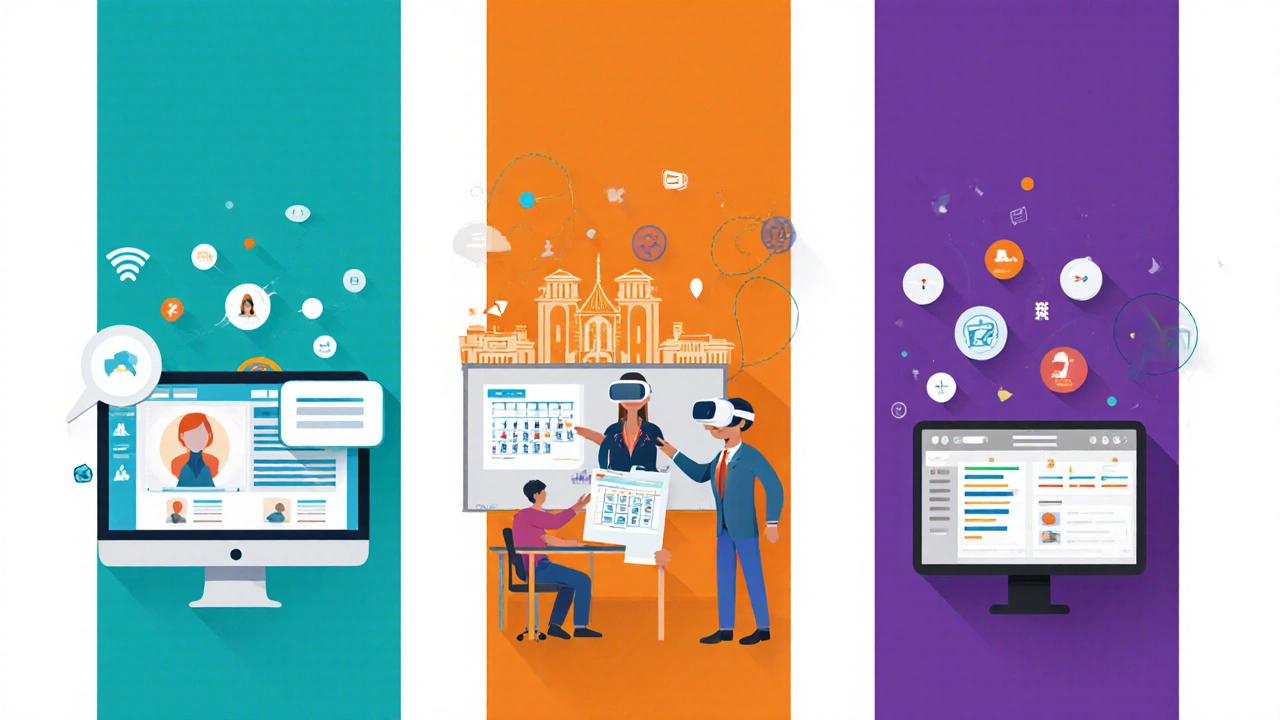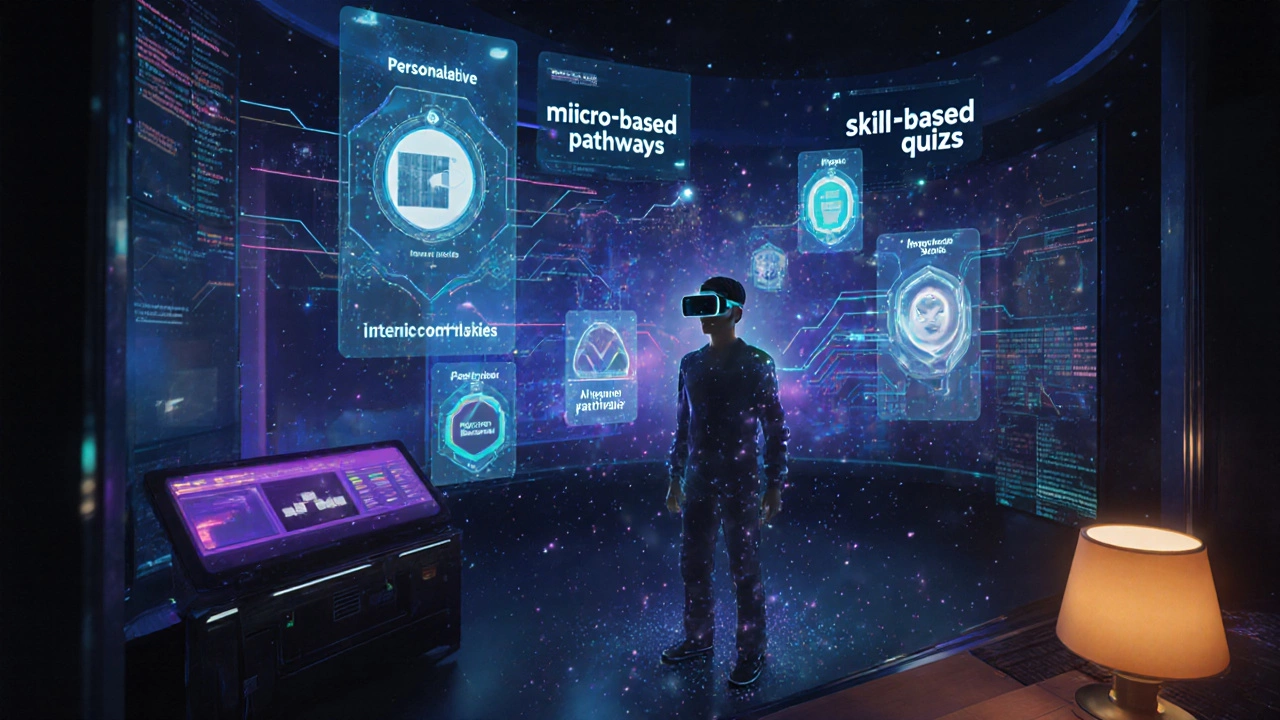Key Takeaways
- eLearning goes by many names-online learning, digital learning, distance education, virtual learning, and more.
- Each synonym carries a subtle nuance that matches a specific delivery method or audience.
- Choosing the right term helps you communicate clearly with learners, employers, or platform providers.
- Most modern programs blend several approaches, so hybrid terms like "blended learning" often appear.
- A quick reference table lets you match a term to its core definition and typical use case.
When you hear people talking about "eLearning," you might wonder whether there’s a single, universal label or if the industry uses a whole family of terms. The short answer: there isn’t one‑size‑fits‑all. Over the past two decades, educators, tech vendors, and corporate trainers have coined several names that overlap but also highlight distinct aspects of digital education. This guide breaks down the most common names, explains what each really means, and shows you when to use the right one.
What Is eLearning?
eLearning is a form of education that uses electronic devices-typically computers, tablets, or smartphones-to deliver instructional content over the internet. The "e" stands for electronic, and the model can be fully online, partially online, or a mix of online and face‑to‑face sessions.
Because eLearning can be synchronous (live) or asynchronous (self‑paced), it has become the umbrella term for most modern digital instruction. Yet, the phrase itself is often swapped out for more descriptive synonyms that hint at the delivery style, technology, or learning environment.
Common Synonyms and Their Nuances
- Online learning is a broad label for any education that occurs via the internet, whether through video lectures, interactive quizzes, or discussion forums. It emphasizes the networked nature of the experience.
- Digital learning is a catch‑all term that includes online learning but also offline digital resources like e‑books, simulation software, or downloadable PDFs. The focus here is on the medium-digital rather than paper.
- Distance education refers to formal courses designed for learners who are physically separated from the instructor, historically delivered via mail or broadcast TV and now largely via the web. It highlights the separation between teacher and learner.
- Virtual learning is a term that stresses the use of immersive or simulated environments, such as 3D campuses, VR classrooms, or gamified platforms. The word "virtual" often signals more interactive, visual experiences.
- Web‑based training (WBT) describes instructional modules that run directly inside a web browser, typically without the need for additional software installations. It’s a favorite phrase among corporate L&D teams.
- Blended learning combines online components with traditional in‑person sessions, creating a hybrid model that leverages the strengths of both. It’s often used when schools want to retain some classroom interaction.
- Mobile learning (mLearning) focuses on learning experiences optimized for smartphones and tablets, often through apps, short videos, or push notifications. The term stresses portability and bite‑size content.
- MOOCs (Massive Open Online Courses) are large‑scale courses offered free or at low cost to anyone with internet access, usually hosted on platforms like Coursera or edX. While technically a form of eLearning, the acronym itself has become a brand.
- Learning Management System (LMS) is a software platform that stores, delivers, and tracks eLearning content for organizations and schools. People sometimes say “We’re using an LMS” as a shorthand for the whole eLearning setup.
- Asynchronous learning lets students engage with material on their own schedule, using pre‑recorded videos, forums, or self‑graded quizzes.
- Synchronous learning requires participants to be online at the same time, as in live webinars, virtual classrooms, or real‑time chats.
How the Terms Evolve with Technology
From the early days of CD‑ROM tutorials in the 1990s to today’s AI‑powered tutoring bots, each new tech leap has spurred a fresh label. For example, the rise of immersive 3‑D platforms gave birth to “virtual learning,” while the ubiquity of smartphones popularized “mobile learning.” When a term catches on, it often signals a shift in how learners expect content to be delivered.
That evolution matters because it shapes expectations. If you market a course as a "MOOC," potential learners anticipate open enrollment, peer forums, and a self‑paced structure. If you advertise "blended learning," they’ll expect occasional face‑to‑face labs or workshops. Using the right synonym therefore aligns marketing, curriculum design, and learner satisfaction.

Choosing the Right Name for Your Audience
Here’s a quick decision guide:
- If your program is 100% internet‑based and you want a generic, universally understood label, go with online learning.
- If you emphasize the digital format beyond just the web-e.g., apps, e‑books, simulations-choose digital learning.
- If the learner is physically remote from an institution (e.g., a rural student), distance education resonates best.
- If you’re leveraging VR, AR, or game‑like environments, brand it as virtual learning to highlight interactivity.
- For corporate training that runs inside a browser without extra installs, the term web‑based training (WBT) sounds professional.
- When you mix classroom hours with online modules, label it blended learning to set the right expectations.
- If most of the content is consumed on phones, use mobile learning (mLearning).
- For large, open‑access courses that anyone can join, the acronym MOOCs is the most recognizable.
- When your focus is the backend platform rather than the pedagogy, refer to your Learning Management System (LMS).
Remember, many programs comfortably sit under multiple labels. It’s okay to call your course both "online" and "mobile-friendly" if those features matter to different stakeholder groups.
Quick Reference Comparison
| Term | Primary Focus | Typical Audience | Common Platforms |
|---|---|---|---|
| Online learning | Internet delivery | Students, professionals | Coursera, Udemy, LMS |
| Digital learning | All digital media | K‑12, corporate | E‑books, simulations |
| Distance education | Geographic separation | Remote learners | Zoom, LMS, mail‑based |
| Virtual learning | Immersive environments | Tech‑savvy students | VR headsets, Unity |
| Web‑based training (WBT) | Browser‑only modules | Corporate staff | Articulate Rise, Storyline |
| Blended learning | Hybrid online + face‑to‑face | Higher ed, K‑12 | LMS + classroom |
| Mobile learning (mLearning) | Phone/tablet‑first | On‑the‑go professionals | Duolingo, app‑based LMS |
| MOOCs | Massive, open enrollment | Anyone worldwide | Coursera, edX, FutureLearn |
Real‑World Examples
Consider three scenarios that illustrate how the same program can be marketed differently:
- Corporate onboarding: A multinational uses an LMS to deliver a series of web‑based training (WBT) modules that employees can complete on any device. The HR team calls it "online learning" in internal communications but advertises the mobile‑first aspect as "mLearning" on the employee portal.
- University extension course: A public university offers a semester‑long class where lectures are streamed live (synchronous) and recorded for later viewing (asynchronous). They brand the offering as "blended learning" because students also meet on campus for labs once a month.
- Free public course: A nonprofit launches a series of video lessons hosted on YouTube, supplemented by discussion forums and quizzes. The campaign markets it as a "MOOC" and emphasizes the "online learning" accessibility for anyone with internet.
Notice how the language shifts to match audience expectations while the underlying technology remains similar.

Future Trends Shaping Terminology
AI‑driven personalization, micro‑credentialing, and immersive analytics are already influencing how we name digital education. Phrases like "adaptive learning" (where AI tweaks content in real time) or "skill‑based learning pathways" are emerging alongside the classic list above. As these concepts mature, you’ll see new hybrids-e.g., "AI‑enhanced virtual learning"-enter the lexicon.
Staying current means monitoring industry reports (e.g., Ambient Insight’s annual eLearning forecast) and updating your terminology accordingly. If you’re a content creator, sprinkle in the newest buzzwords when they truly apply; otherwise, stick with the well‑established synonyms that your audience already recognizes.
Mini‑FAQ
Is "eLearning" the same as "online learning"?
Mostly, yes. Both refer to education delivered via the internet. "Online learning" is a broader, more consumer‑facing term, while "eLearning" is often used in corporate or technical contexts.
When should I use the term "distance education"?
Use it when the key selling point is that learners can study from anywhere, especially if the program has a formal accreditation or is run by an established institution.
What’s the difference between "virtual learning" and "digital learning"?
"Virtual learning" usually hints at immersive tech-VR, AR, 3‑D simulations-while "digital learning" covers any non‑paper format, from PDFs to interactive videos.
Are MOOCs considered "eLearning"?
Yes. MOOCs are a subset of eLearning that are massive, open, and usually free or low‑cost.
How does "blended learning" differ from "hybrid learning"?
Both mix online and face‑to‑face, but "blended" often implies a pedagogical design where online content replaces part of the classroom time, whereas "hybrid" can simply mean offering two parallel delivery modes.
Next Steps for Content Creators
1. Audit your current copy. Identify which synonym you’re already using and whether it matches the learner’s expectations.
2. Map each course feature to a term. For example, if you have a mobile app, add "mLearning" to your tagline.
3. Update SEO metadata. Include the chosen synonym in the page title, meta description, and heading tags to capture search traffic.
4. Test language with your audience. Run a short survey or A/B test two headlines - one using "online learning" and another using "digital learning" - to see which resonates more.
5. Stay flexible. As new tech arrives, revisit the terminology list and add fresh entries like "AI‑enhanced learning".
By mastering the nuanced vocabulary of eLearning, you’ll speak the same language as your learners, partners, and search engines alike. Whether you call it online learning, digital learning, or virtual learning, the core promise stays the same: accessible education powered by technology.




